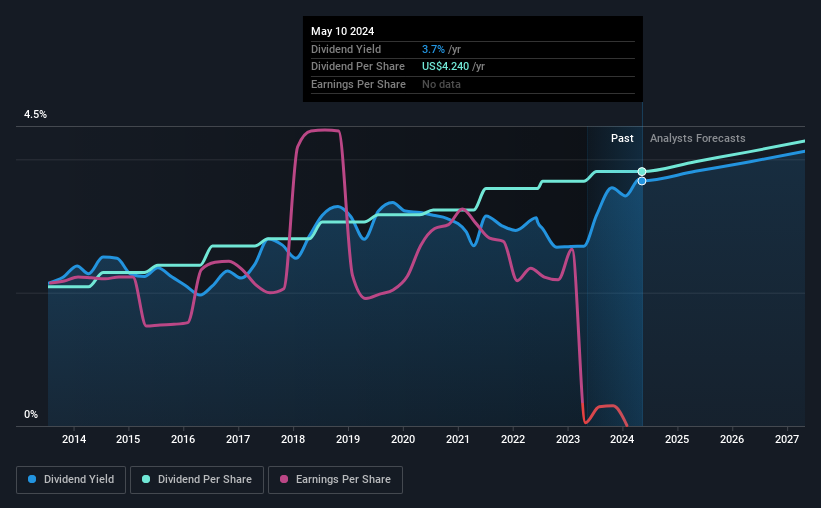Please use a PC Browser to access Register-Tadawul
Why It Might Not Make Sense To Buy The J. M. Smucker Company (NYSE:SJM) For Its Upcoming Dividend
J. M. Smucker Company SJM | 0.00 |
The J. M. Smucker Company (NYSE:SJM) stock is about to trade ex-dividend in 4 days. The ex-dividend date occurs one day before the record date which is the day on which shareholders need to be on the company's books in order to receive a dividend. The ex-dividend date is important as the process of settlement involves two full business days. So if you miss that date, you would not show up on the company's books on the record date. Therefore, if you purchase J. M. Smucker's shares on or after the 16th of May, you won't be eligible to receive the dividend, when it is paid on the 3rd of June.
The company's next dividend payment will be US$1.06 per share. Last year, in total, the company distributed US$4.24 to shareholders. Looking at the last 12 months of distributions, J. M. Smucker has a trailing yield of approximately 3.7% on its current stock price of US$115.34. Dividends are an important source of income to many shareholders, but the health of the business is crucial to maintaining those dividends. So we need to check whether the dividend payments are covered, and if earnings are growing.
Check out our latest analysis for J. M. Smucker
If a company pays out more in dividends than it earned, then the dividend might become unsustainable - hardly an ideal situation. J. M. Smucker paid a dividend last year despite being unprofitable. This might be a one-off event, but it's not a sustainable state of affairs in the long run. Given that the company reported a loss last year, we now need to see if it generated enough free cash flow to fund the dividend. If J. M. Smucker didn't generate enough cash to pay the dividend, then it must have either paid from cash in the bank or by borrowing money, neither of which is sustainable in the long term. Over the last year it paid out 67% of its free cash flow as dividends, within the usual range for most companies.
Click here to see the company's payout ratio, plus analyst estimates of its future dividends.

Have Earnings And Dividends Been Growing?
Companies with falling earnings are riskier for dividend shareholders. If earnings decline and the company is forced to cut its dividend, investors could watch the value of their investment go up in smoke. J. M. Smucker reported a loss last year, and the general trend suggests its earnings have also been declining in recent years, making us wonder if the dividend is at risk.
Many investors will assess a company's dividend performance by evaluating how much the dividend payments have changed over time. Since the start of our data, 10 years ago, J. M. Smucker has lifted its dividend by approximately 6.2% a year on average.
Remember, you can always get a snapshot of J. M. Smucker's financial health, by checking our visualisation of its financial health, here.
To Sum It Up
Is J. M. Smucker worth buying for its dividend? It's hard to get used to J. M. Smucker paying a dividend despite reporting a loss over the past year. At least the dividend was covered by free cash flow, however. Overall it doesn't look like the most suitable dividend stock for a long-term buy and hold investor.
So if you're still interested in J. M. Smucker despite it's poor dividend qualities, you should be well informed on some of the risks facing this stock. Be aware that J. M. Smucker is showing 3 warning signs in our investment analysis, and 1 of those is potentially serious...
Generally, we wouldn't recommend just buying the first dividend stock you see. Here's a curated list of interesting stocks that are strong dividend payers.
This article by Simply Wall St is general in nature. We provide commentary based on historical data and analyst forecasts only using an unbiased methodology and our articles are not intended to be financial advice. It does not constitute a recommendation to buy or sell any stock, and does not take account of your objectives, or your financial situation. We aim to bring you long-term focused analysis driven by fundamental data. Note that our analysis may not factor in the latest price-sensitive company announcements or qualitative material. Simply Wall St has no position in any stocks mentioned.



